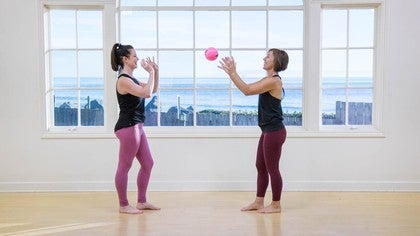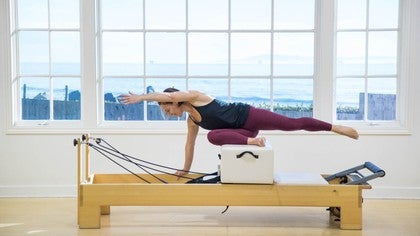Description
About This Video
Transcript
Read Full Transcript
Hello, I'm Louise Johns and this is Erin and I forgot her last name. Erin Wilson. And she and I have never met before. We literally like five minutes ago. What I wanted to do to get today with Aaron, like I do with many of my clients is kinda ground her a little bit. Talk to her about her vision, her balance and this whole idea about falling out of balance. So what does that mean am it's one thing to balance on one foot.
I'm sure Aaron, she's applied, his teacher can balance really well. What I want to look for is her strategy of how she falls out of balance, what her recoil action is and reaction is and how she, how she behaves in time and space. Why is this important? Well, first of all, if she were to fall, trip and fall, it's the one biggest rep max you'll ever do. It's more power produced in a one one rep, max befalling. So that's really important. So I like to talk to clients about that. And also the vestibular system, her in the end where she is in time and space and her eyes.
So her eyes aren't going, then she's not going either. And we're going to talk all about that. This is also useful for chatty Cathy who comes in. She's really excited or he's really excited and I try to downregulate them a little bit so we can actually get some work done. And so his, Aaron, I'm going to have a face maze so just go ahead and stand there and we've never met. So I'm just going to step back and check her out a little bit and see what her body's telling me.
And I find often standing behind my clients is easier then they don't have to look at me and we don't have to have that awkward eye contact if we don't know each other very well. So first of all, Aaron, I'd like to get you in your sensing body so she can get a feel for where she is and time and space. And so the best way to do that is through the breath of festival. Yeah, she does take a nice breath. Take a nice inhale through your back body, hold your breath at the top of the breath. And then just allow your mouth to open and let the breath fall out. Yup. Would down-regulating take a nice deep breath in and then out. And then keep your breath. I'm observing her and checking out where her breath is going.
I'm going to bring my hands to you. Is that okay, Aaron? And so I'm going to invite you to take your breath more posterior lateral. So she's going to breathe in and out. I'm gonna place my hands on her shoulders and then take another deep breath in through your rib cage in the back. Yeah, that was way better. So self touch and or external touch. Do one more time.
Increases your awareness, which is your propioception and then down. That's super nice. Now we turn to a regular breath. What I'd like you to do is get a sense of your body, not your physical body, but how you take up shape space in the room. So for example, think about and bringing my hands to you. The shape between your body and your arms. She's just thinking about them.
She's not making a judgment. She's just thinking about how her arms and the shapes that get made. And I'm also looking at those shapes. And then I want you to think about the shapes that happen between your legs, your right and left leg. That shape is usually like a triangle shape. Like what does that feel like?
Give them a couple of seconds to just explore and then think about the shape that's underneath your feet. So in the arches, the shape, the floor is giving us some feedback and it's similar to the shape that's in the soul, the palms of your hands, soles of your feet, palms on their hands. And then I'm gonna bring my hands to you once a month and come around this way so I don't start all her. And then I'm going to bring my hand in an OSCA to think about this shape that's in her throat. And there's all [inaudible]. Please say similar shapes, these cuff shapes. And already she may beginning to feel a little bit more relaxed. Let's try to take habit, take another inhale, breathe in and out.
And I don't know if you can see this, but that breath was way better. Breathe in. Then the last breath that she took before. Okay. Now I want you to do is go ahead and reach your arms above your heads. Good. And then when you reach your arms above your head, fully reached like yes, she's really reaching. And then take the arms wise all the way down this coronal plane down here and then take them back the way you came.
So we're just thinking about this idea that you have all this shape on all this base. Yep. And again, breathe in mind that nice breath. She's filling up the room. Good. Now how about we change that shape and we go forward and back up big all the way. Go all the way to the top, all the way to the top. Hands come together and then all the way out and then switch sides. So now she's thinking about this plane of motion as well.
And now as we may have to do one more, she's enjoying it. That's why she's doing it. Now I would like you to just rotate. So on the transverse plane [inaudible] and I'm looking at her eyes. I'm looking to see if her eyes are tracking her hands. I'm where her eyes go. And now I want you to take that in 360 degrees. So in other words, turn all the way around. Yes. Yeah.
And then go all the way the other way around. So she's, she's laughing a little bit. She feel uncomfortable to that the other way, and it's also joyful, a little bit playful. And again, I'm looking at her eyes this time. Look to your left as you go left brilliance and bring it down and then bring the arms down. Catch up. All right, so now she's feeling like there's all this space right now. Let's take right hand and touch left. And I'm just throwing the cues at her. I'm not overly instructing her little right left brain connections. When our hands pass over the midline, her brain half's taught to one another.
Neuro-plasticity is there another way that you could do that? She's thinking, how about behind you? Oh yeah. She's like, Oh yeah, I could do it behind me. How about in France? How about you touch a different part of your leg and then how about you go behind you? So I'm just getting her brain warmed up. I'm also looking to see how she tracks the movement, what her eyes do, and she's having a little playful little playful time. Yes. Notice I'm not doing too much. And then come to a standstill. Relax your body, close your eyes for a second, and then maybe you notice a little bit of kinetic energy. Yeah, she feels a little vibration and you might do two if you're doing it with us, that's that kinetic energy. While she's got her eyes closed, I'm going to get out some toys. She's not seen them before. Okay.
Open your eyes. Oh, it's a nice pink ball. So a lot of that didn't bounce as well as I thought it was going to do. I was expecting it to rebound. So a lot of this work I got from the Z health and Trent McEntire, so I'm going to give her this and she's going to feel it. She can get tapped out and then you're going to pass it back to me and I'm going to pass it back to you and you're going to pass it back to me.
So what I'm looking for is how her eyes track the bowl. So as we age, we don't do such a great job that her brain is focused on this extrinsic task. All right, so how are you throwing and catching? She doesn't know. So I don't know either. So I'm going to get close. I'm going to throw her the ball. When I throw her the ball, I'm asking to tell me a color, color and another color.
Purple [inaudible] and another color. Yeah. And keep going. So she's telling me colors and she's focusing on the colors being cooled out. If I had numbers keep going on the wall, I would have a cool, the numbers, her brain, she's multitasking. She's taking in a lot of information. One more time and she's running out colors. So avid client, he's 89 and we do this drill and we talk about food or names of insects and all.
We use the brain speed bomb. Now we're going to check your peripheral vision. All right? And so you're going to here's the bowl. Try looking in that direction as I take the ball and you're going to tell me, do you see it? Do you see it now? Do you still see it? No. See it right here. Okay, so that's pretty good. She's all the way over here. Excuse my back cause I come this side. Do you see it now? Yeah.
So now place your arms where you feel that your peripheral vision is and let's see. Do you see it now? Yes. Okay. And do you see it now? Yes. So just going to keep our eyes there and so keep looking forward. Don't look at the ball. Tell me when it starts to disappear. Like right there, right there. She's going to bring our hands down and touch the bowl and go back out to the sides. Now I'm not tall enough to go above her head, but let's say if I went up, go ahead and go up.
Use your fingers and track seeing your fingers rather than the bowl. And then basically draw that. I like to call it the goldfish bowl to go out all the way. She's working on her peripheral vision. She's looking forward, but still checking her eyes. Your ocular nerve takes up 85% if your brain power, it's a lot of brain power the whole time.
So she's looking at that and now she's going to bring your arms down. So if she was afraid of falling, we might have a conversation about if you say you're 80 years old or maybe you're not, maybe you've just come out of the hospital, you've had surgery, and kind of give me that recessed posture and then she might look down, right? She's afraid of falling. So typically what happens is the eyes go to the ground, but when she brings her body up and inside her peripheral vision, so Aaron, we know that you can see this 360 degrees. So when you look out of this beautiful view, no that you can see to the sides, she can see above and she can see below. She says, yes I can. So if she was to walk forward, let's have a walk back.
First of all, so come with me that's come over here. If she was afraid of falling, we would encourage her to take a note of your peripheral vision and I might use something like this to keep her engaged in her peripheral vision so she to reassure her, remember you could see all of this and then as she walks slowly forward, she's going to keep a check on her peripheral vision as she walks, as she's taking a note of up-down and why it's not a big deal for her because she's a happy, healthy mover, but when you're not, this is quite a big deal and then she's going to stop. Now I'm going to use sub touch and ask her to come back towards me, keep coming back towards me, Aaron. So for example, if she had Parkinson's or cerebral palsy or something that she wasn't able to move as well, this is going to be really helpful. As she walks towards me, keep coming there, Aaron, come to me, come to me, come to me and we'll do stop and then walk forward in the same way that you did before. Eyes are on the horizon, checking her peripheral vision. Now in my studio we've got about 4,000 square feet. So we can go quite far, but we've got this little space here and then stop to make it a little bit more complicated. I'm not going to touch her this time. Go ahead and come towards my voice. Take a biggest stride and come towards me.
Keep coming, keep coming. Keep your peripheral vision, notice the things that are left and right of you and then go ahead. Nice job. Now walk forward by herself and then walk back. This can sometimes take several weeks, but it's interesting to watch the competence and the individual as they walk forward and back. I was that. Well, so what you're saying is have a super the system, so her inner ear, right when we give me that recess posture, so now she's here, her in the air is on a different level. So it's like riding in an airplane, right?
You've got your cockpits and now the planes light, we're going this way, we're going down. So if she can get a nice head neck position, go ahead and come on up and bring her vestibular system up on the horizon. Allow it to tell her what's forward, what side and what's back. She's much more confident and we could go on about that for ages, but I'm going to give us some other playful things to do. I'm going to give her this and she's going to just bounce it on the ground. It doesn't bounce for you.
When you're chopping your vegetables, you have to track your eyes, what they're doing when you're driving your car, tracking your eyes and stop and let go. And then how's your tennis playing?
So all she's gonna do is hold it steady and I tennis racket. Yep. And then throw it back at me. And so this could be me doing the throwing and her receiving and vice-a-versa Justin playful games and back. So let's switch as in, I'm now bets are off. Okay, go. So I'm actually quite anxious. So there's that startle reflex that I need to get my brain going.
Yep. So our business partner, Claudia moose, she had an arterial vertebral dissection and so she's got some nerve stuff going on. This is a really good drill beheaded. Do ms Claudia, I'll be coming to you with this shortly and then stop. Okay, one last thing today as the bolts go flying, this is how it is in my studio too. So we have all our stuff everywhere. I want to check, um, her ability to walk stray and or her balance. So let's lay this down. Aaron on the floor. We wanna just do one to begin with. Now don't fall over that metal. There's a metal piece on here, so please don't hurt yourself.
And so what I want you to do is festival, just walk along the strap, not giving you any particular instructions on it. See if you can walk on it for me. Yeah. On it. So if you can walk on it. Yeah. So just walking like she was walking on a tight rope. I'm checking to see what has strategy is for balancing. Pretty nice. Okay, so now this time, um, sometimes I might take somebody outside, but I'm going to have you just rub your feet on the ground.
Something I'm trying to increase her and maybe stamped it will these nerve endings in our skin. So I'm trying to stimulate her feet a little bit. So this time when you walk across the yoga strap, come up on the balls of the fee. I'm trying not to show what to do so she doesn't anticipate. And so now her feet are a little bit more primed. You might stand on one of those rock mats or do it a little bowl rolling.
So now just increased her awareness of her feet so she can get a sense of the tactile feeling of the yoga strap against her feet and come on down. And how was that hot? Right? She's hot. She's a good happy movie. Yeah, that'll be good. We're going to make like a little runway. So come out right about here. That's brilliant. Okay, so now she's going to stand right here next to me. She has no idea what we're doing.
And I want you to use the peripheral vision that we used earlier on, and then just relax and walk through the strap. So she's walking down the straps, no big deal. And then she's going to turn around and come back walking down the straps. No big deal. So now this time when she walks down the straps, I'm going to challenge her vestibular system and have a look at me and look away. So when I say, look at me, look at me. And when you're not looking at me, you're looking at the ocean. Okay, so we're walking, look at me and back and look at me and back and look at me and backend stop. How was that different? Yeah, she's, she's, that's our Vista for the system, right? It's trying to get online. It's that airplane.
It's trying to get all of those apparatuses to fly on the horizon. All right, we're ready. So you've got to walk in between the lines. She's anticipating and look at me and away. Look at me and away. Look at me. Anyway, she was a little bit better this side. Let's do it again. Okay. So I can do many different things. Okay. Look at me. How many fingers look at me. How many fingers? Yes. Look at me. How many fingers? Yeah. Good job. 10 arounds. And I got to say this side, this time. Ready? Go look at me.
Look at me. Look at me. Look at me. Wow. Nice job. So it was interesting cause when I put six up her eyes she had little Stossel. So that's also reflex is really what we're looking for. So I'm going to take these away, put them to the side and now I'm going to go back to some of the drills that we did at our their arm and we're going to see how she has, she does.
Is they as there any improvement, is there any other way that you can do the movements? We're looking for that gentle improvement. It may not be huge as the brain resets itself and she connects. And then how about that? Your peripheral range [inaudible] going up and down and then maybe I'm in front and in back and just moving casually back and forth.
And then how about the around them? They're around. So when we were about two years old and the other way, that's when the toddler comes home and they start Wu spinning around in circles. So I encourage you to go a little bit further, a bit quicker, exploring the Vesuvius system and then around, get a little dizzy, do to more, get a little dizzy, a little dizzy, one more, get a little dizzy. And I'm going to come in as biocide and I might just come here just in case they go down. It's not a good idea. Yeah. How do you feel? Yeah, she feels good. Quicker. Yeah.
She felt quicker and so now she's ready for some movement. Now she's down-regulated. She's aware of herself. We've done a little right left brain. We've done a little vestibular system. We've played a few games, and that might be all that we do for this session, but I'm going to take a through a primal workout. So let's do that next.
Active Aging - Playlist 5: Falling Out of Balance
Comments
You need to be a subscriber to post a comment.
Please Log In or Create an Account to start your free trial.
















